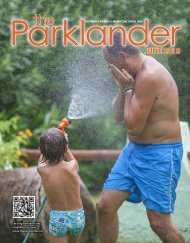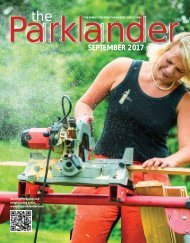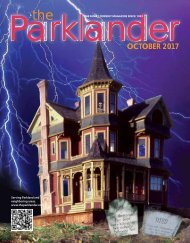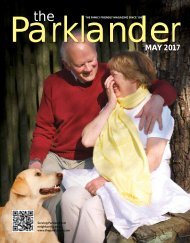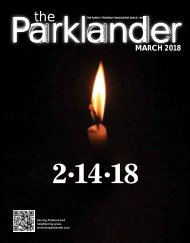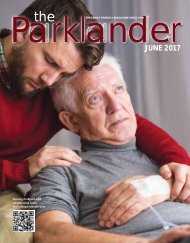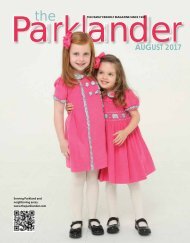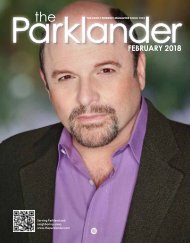January 2017
You also want an ePaper? Increase the reach of your titles
YUMPU automatically turns print PDFs into web optimized ePapers that Google loves.
State Sen. Eleanor<br />
Sobel, D-Hollywood,<br />
left, and Rositta<br />
Ehrlich Kenigsberg,<br />
who says the senator<br />
offered “unbelievable<br />
support” for facilities<br />
that recall details of<br />
the Holocaust.<br />
Founding chair of the first Children of Holocaust Survivors<br />
Group created in South Florida in 1981,Kenigsberg was born<br />
in the Displaced Persons Camp of Bindermichl in Austria. Her<br />
fight for a proper, public, and accessible venue to maintain<br />
Holocaust memories and history was “a promise I made to<br />
my father,” and one that has gained solid and considerable<br />
support from many Floridians, among them, state Sen.<br />
Eleanor Sobel, D-Hollywood.<br />
She and many lawmakers gathered in 1994 when Gov.<br />
Lawton Chiles signed a bill mandating Holocaust education<br />
in all public schools in the state, from kindergarten through<br />
college and university levels. “Every Florida student will have<br />
the opportunity to learn that promises of ‘Never Again’ are<br />
empty and meaningless if we remain silent and indifferent in<br />
the face of any hatred, bigotry, and bullying.”<br />
The HDEC has spent 36 years making a museum happen.<br />
It has already created a research library and administrative<br />
offices in the Dania Beach building along with two anchor<br />
exhibits – a U.S. Army M-4A3E8 Sherman Tank, the same<br />
type that helped liberate the Dachau prison camp in 1945,<br />
and a Polish railroad car, which, according to Nazi code<br />
numbers found underneath, was one of the vehicles that<br />
carried innocent victims to Nazi death camps. It is one of only<br />
nine on display around the world.<br />
By creating oral histories, the center “will<br />
put names and faces to the victims, raising<br />
the sounds of their moral voices of conscience<br />
to mute the noise of prejudice and hatred,”<br />
Kenigsberg said.<br />
The HDEC’s Documentation Department continues to<br />
videotape interviews with survivors, liberators, rescuers, and<br />
other eyewitnesses to preserve their stories.<br />
Kenigsberg helped create the U.S. Holocaust Museum in<br />
Washington, D.C. and lent institutions such as the United<br />
Nations, Steven Spielberg’s Shoah Foundation, and the Simon<br />
Wiesenthal Center the expertise to develop oral histories of<br />
their own.<br />
To date, the Dania Beach facility has some 2,500 stories in its<br />
spoken history collection along with 6,000 volumes of Holocaustrelated<br />
books, journals, DVDs, and videos from that era.<br />
The existing HDEC has won praise for taking its programs<br />
into communities in Miami-Dade, Broward, Palm Beach,<br />
and Monroe counties. Annually since 1986, the center has<br />
conducted Student Awareness Days that not only educated<br />
children and young adults from middle and high schools,<br />
colleges and universities, but also give them a chance to<br />
meet and speak with Holocaust survivors.<br />
Kenigsberg said young people are also aware that<br />
extermination of races is still practiced today. “In light of the<br />
ongoing problem of genocide in our times and the inadequacy<br />
of the world's response to it, we must sensitize future<br />
generations to remain vigilant and responsive in this.”<br />
The HDEC also has a division linking Holocaust speakers with<br />
schools, community organizations, churches, synagogues,<br />
state, and federal agencies.<br />
Kenigsberg promises the museum Holocaust stories “will be<br />
appropriate for ages 11 and older, with parental discretion<br />
advised. The design will take a multimedia, state-of-the-art<br />
approach, combining pictures, text, audio and interactive<br />
displays.”<br />
One survivor eager to see completion is Julius Eisenstein, 97,<br />
of Hallendale Beach. A native of Poland, he was moved from<br />
a Polish ghetto to Blizin Labor Camp and held at four other<br />
internment centers until 1945, when he was liberated. During<br />
a Student Awareness event at the NDEC, he met one of the<br />
people who liberated Dachau – the last place he was held.<br />
“I made arrangements with God that He should not take<br />
me away before the opening of the museum,” Eisenstein<br />
said. “I want to make sure the future generations know what<br />
happened.” P<br />
Julius Eisenstein<br />
and Rositta Ehrlich<br />
Kenigsberg<br />
shown holding a<br />
plated photo of<br />
the liberation of<br />
Dachau.<br />
the PARKLANDER 51





